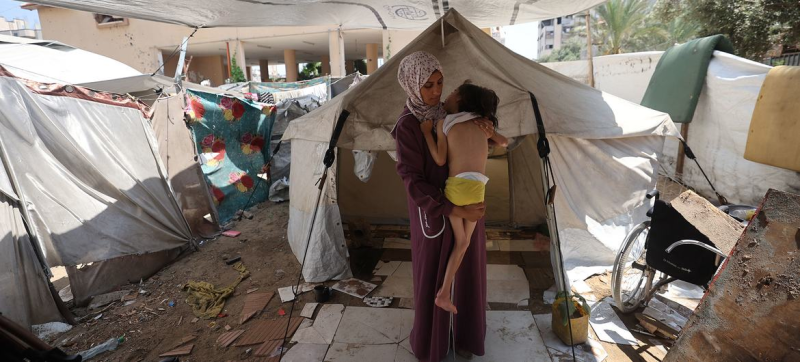- OIC Hails Belgian Declaration of Intent to Recognize Palestinian State |
- Bomb blast kills 15 near political rally in Pakistan |
- Corruption Persists Despite Uprising, TI Chairman Warns |
- Gaza Attacks Intensify as Disabled, Hungry Civilians Suffer |
- Stock indices edge up in first hour at DSE, CSE |
Gaza Attacks Intensify as Disabled, Hungry Civilians Suffer

A displaced mother struggles to address the complex needs of her seven-year-old severely malnourished daughter with cerebral atrophy.
Thousands of Palestinians have been caught in the crossfire while trying to escape attacks and severe food shortages in war-torn Gaza, facing extraordinary challenges, according to the latest reports from UN officials and the Committee on the Rights of Persons with Disabilities.
A 14-year-old girl with cerebral palsy, dependent on a wheelchair, was among the crowds fleeing Israeli military operations east of Rafah in Gaza on 13 October 2023, said committee member Muhannad Salah Al-Azzeh, who presented a report on the occupied Palestinian territories on Wednesday in Geneva. In the chaos, she lost her wheelchair.
“She was crawling on the sand and telling her family, ‘you can leave me here,’ because she felt she was slowing them down,” he said.
Many people remain unaware of evacuation orders in Gaza due to their disabilities since the start of the nearly two-year-long war triggered by the Hamas-led attack on Israel.
“This is one of the most serious issues because, in emergencies, persons with disabilities are often excluded. For them, it’s even more complicated,” Mr. Al-Azzeh added.
Following extensive interviews with individuals, delegations and organisations in Gaza and the West Bank, the UN committee submitted a series of recommendations and concerns to Israel and the Palestinian Authority.
“The situation in Gaza is a grave concern,” Mr. Al-Azzeh said. “We believe all State parties to the Convention on the Rights of Persons with Disabilities have failed, in one way or another, to fulfil their obligations to protect and ensure the minimum rights of persons with disabilities during this emergency.”
He cited grim cases, including one where prolonged electricity shutdowns in Rafah prevented a mother from receiving evacuation messages on her phone. She and her children were later killed in an Israeli strike.
In another case, nine-year-old Noor’s deaf parents relied heavily on her to survive Israeli tank shelling. She had to learn new sign language vocabulary for war terms such as tanks, quadcopters, shrapnel and aircraft.
There are also dozens of cases like that of Abdulrahman Al-Gharbawi, a 27-year-old graphic designer with cerebral palsy and lower limb disability. Each of the nine times his family has been displaced since the war began, his mother carried his wheelchair while his father and brother carried him.
The UN Office for the Coordination of Humanitarian Affairs (OCHA) warned on Wednesday that the intensification of the offensive on Gaza City, amid famine, risks pushing civilians – already battered and bereaved – into an even deeper catastrophe that world leaders must act to prevent.
“Partners supporting displacement sites warned that escalating hostilities in Gaza City are having horrific humanitarian consequences for people living there, many already displaced from North Gaza,” OCHA said. Many households cannot move due to high costs and lack of safe places, with the elderly and disabled especially at risk.
Between 14 and 31 August, more than 82,000 new displacements were recorded, including nearly 30,000 movements from north to south, OCHA reported.
Humanitarian efforts continue to face major obstacles. Although some aid is reaching Gaza, deliveries remain severely limited, according to OCHA’s latest situation report.
Between 17 and 30 August, partners transported over 6,900 metric tonnes of wheat flour, food parcels and bulk food supplies into Gaza. However, most of this aid was seized by desperate crowds or looted by organised groups along convoy routes, preventing proper distribution to households and warehouses.
Since 20 July, when regular food cargo shipments resumed, less than 40 per cent of the 2,000 tonnes of daily food aid required to meet basic needs has entered the Strip. Civilians continue to be killed and injured either by military strikes or during violent chaos around aid convoys.
As of 30 August, 99 kitchens supported by 19 partners were preparing 468,000 meals daily across Gaza, OCHA reported. This relied mostly on the two per cent of food aid that safely reached warehouses, supplemented with resources from local markets.
While meal production rose compared with early August, it still fell far below the more than one million meals produced in April during the ceasefire, when more supplies entered Gaza.
The UN and partners have stepped up famine response efforts following a report confirming famine conditions in parts of Gaza. Initiatives include scaling up meal provision, promoting small-scale gardening, expanding cash assistance and pressing Israel to allow more goods in, particularly food, nutrition supplies and cooking gas.
For the first time in over five months, concentrated fodder for livestock was allowed in, but cooking gas has remained blocked for the same period, leaving people to rely on waste and scrap wood for cooking, increasing health risks.
Meanwhile, UNRWA health facilities continue to serve around 132,000 patients with chronic illnesses, but insulin stocks are expected to run out within two weeks, endangering 16,000 diabetic patients. Access to clean water is also severely limited, and hospitals face critical shortages as casualties mount daily.

